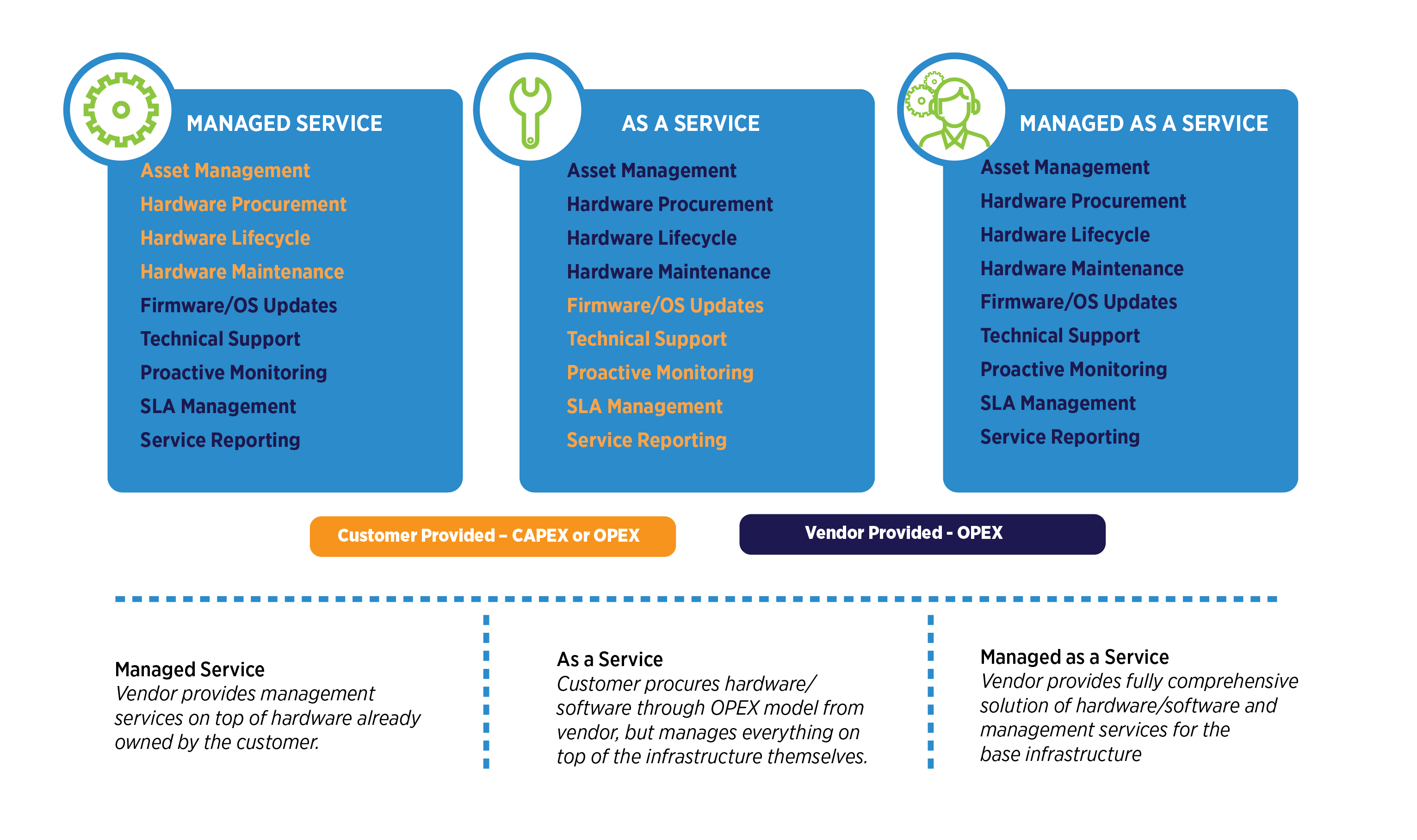You may be familiar with Software as a service (SaaS), but the “as a service model” works far beyond software as an option for technology across the IT spectrum. As a service is simply a model to change the delivery and procurement mechanism to obtain applications, hardware or business functions through technology, moving from traditional capital expenditures to operational expenditure. The as a service model allows organizations to seek outcomes rather than technology, and leans on the expertise of the industry to implement technology to achieves both current and future outcomes required. Today, organizations are looking to as a service models to modernize their infrastructure and facilitate digital transformation through services such as network as a service and/or cloud as a service.
Network as a Service
In the past, agencies practiced network modernization through annual lifecycle refreshes of hardware, which took many resources and years to accomplish. This methodology worked while technology was being contained in single data centers, however as organizations embrace distributed networks, Internet of Things (IoT) capabilities, and rapidly expanding requirements, capital budgets for refreshes are often spent on adding new capabilities rather than modernizing existing ones. Network as a service provides a way to consume networking capabilities to achieve both current and future requirements. In the as a service model, the service provider takes responsibility for not only ensuring the network is continuously running at optimal levels, but also makes it incumbent upon the provider to integrate new capabilities into the network platform to ensure future requirements are able to be consumed without major lifecycle refreshes.
Through a fully managed as a service model, the risk of owning the assets and ensuring functional levels is offloaded to the service provider. This allows in-house IT teams to focus on the strategic direction and requirements supporting the agency mission and its end users. By consuming rather than building networking capabilities, modernization can be implemented more quickly to ensure the network is always ready for new and changing requirements.
Cloud as a Service
A critical component of infrastructure modernization is moving functionalities to the cloud. Cloud has enabled agencies to consume infrastructure, applications and software in an as a service model rather than through traditional capital expenditures. When looking to a service provider for cloud offerings, it is important to consider a provider who is well versed in not only public clouds, but also hybrid and private clouds. While cloud offers the as a service model natively, cloud is not a one size fits all approach, and specific capabilities, outcomes, functions and pricing should be used to determine which platform will best suit each individual requirement.
Benefits
Whether it is software, network or cloud, there are three key benefits to an as a service model.
- Quicker technology adoption – By consuming technology based off requirements, SLAs and outcomes, service providers are required to ensure new technology is integrated into the platform so contractual requirements can continue to be met. Users get the maximum functionality out of systems helping them focus on their mission, not on working around technology.
- Shift of risk – An as a service model shifts the risk of platform availability off an agency and onto the industry partner. The pressure to maintain uptime, availability and performance are squarely on the shoulders of the service provider as part of their SLAs. The as a service model also shifts technology acquisition financial risk to the vendor. As an agency develops new requirements, and wants to consume new capabilities, they no longer have to budget for large acquisition costs, but rather for just the small consumption levels they are looking to achieve.
- Relief of IT Resources – As a service models help agencies move out of the IT business and focus solely on providing service that directly drives the mission and their strategy. Airmen focused on cyber threat intelligence should not worry about network availability, functionality, or capacity, but rather on delivering full-spectrum global cyberspace capabilities.

Implementing as a Service in Government
While the benefits may be clear, implementing an as a service model can be challenging for federal agencies as a shift in the procurement model has challenges that need to be considered. Agencies must consider longer contract terms to ensure that the industry can accept the financial risk of owning the assets. Agencies must also become familiar with defining requirements based around functions, outcomes and SLAs rather than specific technology needs. Lastly, identifying demarcation and capabilities of access, security and operations becomes critical to the success of a vendor supplied as a service solution.
It is important to understand that shifting to an as a service model is not always a true cost savings initiative, but service providers can help agencies understand the shift to as a service by providing total cost of ownership and ROI. Components of ROI can include relief of existing IT resources, faster adoption rate of new capabilities, and overall availability of the service.
Extending as a service beyond software helps agencies realize modernization goals more effectively and efficiently than would be possible by keeping the work in house. The specialized expertise and capabilities of service providers are simply not available to internal general IT teams, a group whose strength is understanding and responding to mission needs. As a service models allow each group, agency IT and the service provider, to play to their strengths benefiting the end user with the most current technology available. For more information on Iron Bow’s as a service offerings, visit our website.

COMMENTS